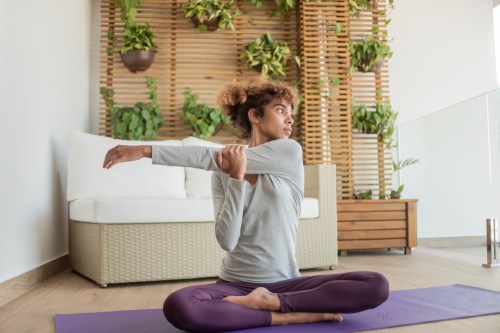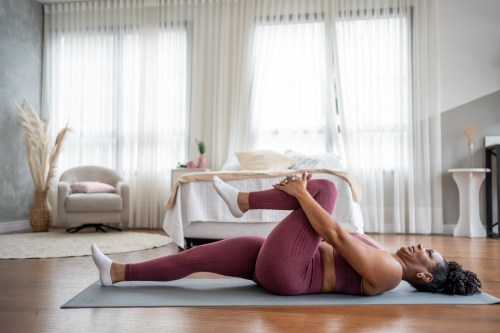Our editors independently select these products. Making a purchase through our links may earn Well+Good a commission
Muscle Knots Are Quite Literally a Pain. Find Some Relief With These 5 Methods
Explore muscle knots and uncover causes and effective remedies. Learn to find relief and prevent discomforting knots for better muscle health.

Sometimes you wake up, and it feels as though there’s a sharp knife or a rock jammed deep within your muscles. Good morning from your newest muscle knot, a particularly “fun” hotspot of tension.
Experts in This Article
orthopedic surgeon and sports medicine specialist
New York City-based chiropractor
But if you don’t know how to treat muscle knots, these lumps can lead to some not-so-fun issues down the line.
What are muscle knots, anyway?
“[A knot] is a muscle fiber or group of fibers that are tense and contracted,” says David Geier, DO, an orthopedic surgeon and sports medicine specialist. Normally, your muscle fibers run parallel to each other, he explains, however, knots in muscles occur when they become disorganized in a localized spot. This happens after an injury or strain to the muscle during which the muscle fibers tear.
Muscle knots are also commonly known as a myofascial trigger points, because they occur in the muscle or fascia (the layer of connective tissue that encases and supports your muscles) and can make you feel limited in mobility.
What causes muscle knots?
They’re incredibly common and are caused by a number of things, including, “the overuse of a muscle, improper use of a muscle, or can be from some type of inflammatory reaction,” says Jay Heller, DC, a New York City-based chiropractor. But you can also develop a knot from sleeping in a weird position, or from poor posture. “That’s why they almost always occur in the upper back, shoulders, and neck,” says Dr. Geier.
A large number of people sit at their desks or at home in less than ergonomic positions. “Getting muscle knots could definitely be increasingly common right now as people work from home,” says Dr. Geier, who stresses that hunching your shoulders forward, slumping, or spending an extended amount of time leaning over a screen can all be culprits for the knots.
Though sometimes a muscle knot can go away on its own, that isn’t always the case—and even if you think it’s not there anymore, it can still affect your body in ways you don’t even realize. “The best case scenario is that, after a short period of time, the knot goes away, which can take one to two weeks,” says Dr. Heller. “But it can—even when you don’t feel it—create a shortening in the muscle that can eventually weaken the muscle and cause problems down the line in that muscle or at the joint where the muscle connects.”
When this happens, it leads to an imbalance in your body. “When one muscle group on one side is tight compared to the other side, it alters your mechanics, and your brain subconsciously shifts stress to other areas and overloads them,” says Dr. Geier, which means that you could get injured again. Or, when there’s a weakness in the muscle from being torn, it’ll throw off your form in workouts or movements. “Instead of lifting straight up, for instance, your body will angle a little bit to not stress that knotted area out,” says Dr. Heller. “So what happens is something on the other side gives out because your posture has been incorrect for a while.”
Not treating a muscle knot can come with the risk of more pain or injuries down the line, which is why taking care to treat it is key. “The pain may go away but that doesn’t mean it got better,” says Dr. Heller. “How you feel could be okay, but you could very well be developing a chronic area of hypersensitivity or weakness in the muscle.”
Preventing muscle knots and squelching them as soon as they arise, keep scrolling for the various methods of treatment.
How to treat and prevent muscle knots
1. Massage therapy
When it comes to relief for muscle knots, you can either turn to a professional massage therapist, chiropractor, or physical therapist for trigger point therapy, or you can do self-massage at home. (FYI: Here’s how often you should get a massage to reap the benefits.)
“Digital pressure and really digging in there can help,” says Dr. Heller, adding that lying on a lacrosse or tennis ball or foam roller can help, as can a percussive massage therapy device—aka a massage gun—like a Hypervolt or Theragun.
If you’re using one of these at-home methods, it’s important to not go too hard on your knot—Dr. Heller says that this can further irritate the spot of tension. So start off slow. But it’s worth noting, massage therapy isn’t supposed to hurt!
2. Stretching
Dr. Geier says that stretching can often help a lot with muscle knots. But it will typically take several sessions (hence why knots are so frustrating).
“You want to stretch the muscle group every day for five days to two weeks, depending on how it heals,” he says.
To make the stretching more comfortable, Dr. Heller recommends applying a topical with CBD or menthol beforehand to sort of numb the area.
3. Light activity
Having a muscle knot can often make exercise, or any kind of physical activity, seem difficult. But light movement is important to keep your blood circulating and to allow your muscles to heal themselves.
If you’re stuck at home all day long, Dr. Geier recommends getting up to move every hour. “Really work on straightening your spine and pulling your shoulders back,” he says.
4. Dry needling
Still wondering how to get rid of muscle knots? A little similar to acupuncture is something called dry needling, one method that’s meant for relieving the built-up tension of muscle knots.
“Dry needling is when you put a certain type of needle right into the point of pain, and it works to help deflate it,” says Dr. Heller. See a certified professional for this one.
FAQ
1. What triggers muscle knots?
There a few common causes of muscle knots, according to Piedmont Healthcare: consistent bad posture, overuse injuries, muscle tension, or a direct injury (like a strain, sprain, or tear) to the muscle.
2. What happens to untreated muscle knots?
If you don’t treat a muscle knot, it can cause increased pain over time. Not to mention, muscle knots can create scar tissue, according to Athletico Physical Therapy. This scar tissue can lead to a loss of muscle elasticity and postural issues that may be hard to reverse. So, it’s best to treat muscle knots right away.
Sign Up for Our Daily Newsletter
Get all the latest in wellness, trends, food, fitness, beauty, and more delivered right to your inbox.
Got it, you've been added to our email list.










